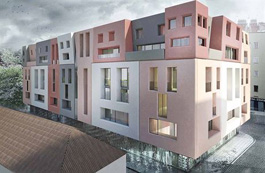
The Heritage Association requests a review of the permit for marshmallow
 |
"I consider the construction of a new residential building on U Milosrdných Street in close proximity to the Convent of St. Agnes, a site used as the residence of the collection of medieval and early Renaissance art and a significant national cultural monument, to be very unfortunate," said the director of the NG, Jiří Fajt. He has been leading the NG for less than a year; the six-story building has been in preparation for many years, and the contracts allowing the use of parts of the land in the convent area were concluded by his predecessors. The vast majority of the land on which the construction is to take place belongs to Prague.
The investor cannot yet start building; besides the fact that the appeal period is still running, the territorial decision for this building will be reviewed based on the decision of the municipal building department.
The project has sparked protests from hundreds of people in recent months. The house was designed by architect Zdeněk Fránek, and the project has been modified several times. Regarding the expanded visualizations, which led people to nickname the house, he says he never accounted for a façade in pink color.
The original form of the project from 2008 was rejected by the Ministry of Culture based on the opinion of the National Heritage Institute (NPÚ) and the permit from Prague's heritage authorities was revoked in 2010. However, the new project by Praga Progetti e investimenti was approved by the NPÚ and municipal heritage authorities, and on this basis, a building permit was issued, although it is still not definitive. According to ASORKD, the new project is even more in conflict with the NPÚ's requirements formulated in the MK's decision that rejected the original project than the previous one.
"The building is bulkier, and the architectural concept is even more aggressive. If the Ministry of Culture is to have a consistent approach, it must respond negatively to this new project for exactly the same reasons as it did in 2010,” said the Association of Associations for the Protection and Development of Cultural Heritage (ASORKD).
The English translation is powered by AI tool. Switch to Czech to view the original text source.
0 comments
add comment
Related articles
0
31.03.2017 | Marshmallow changes owners, whether and when the house will be built is unclear
0
16.03.2016 | Investor of marshmallow is suing the Ministry of Culture
0
29.12.2015 | The marshmallow investor has a zoning decision, not the approval of heritage conservationists
0
25.11.2015 | The Ministry of Culture revoked the preservationists' permit for the marshmallow
0
23.09.2015 | Investor appealed against the cancellation of the decision for "marshmallow"
0
16.09.2015 | The magistrate canceled the issued land decision for "marshmallow"
0
26.08.2015 | The ministry has halted the review, the decision on the marshmallow stands
0
19.08.2015 | Six appeals have been filed against the authorization of Marshmallow
0
19.07.2015 | Marshmallow will also be addressed by the Ministry for Regional Development
0
10.07.2015 | The Heritage Inspection has initiated a review process due to the 'marshmallow'
0
30.06.2015 | The magistrate reviews the zoning decision for "Marshmallow"
0
17.06.2015 | The building called marshmallow has received a building permit from Prague 1
0
29.05.2015 | The association submitted a proposal to the magistrate regarding "Marshmallow"
0
21.05.2015 | The association is complaining to the Ministry of Culture's inspection about "Marshmallow"
18
13.05.2015 | Architekt: I never planned the house "Marshmallow" to be white-pink
0
01.05.2015 | In mid-May, there will be a discussion in Prague about the criticized marshmallow
0
22.04.2015 | There is no reason to appeal because of the "marshmallow," the leadership of Prague 1 has announced
0
15.04.2015 | Hundreds of people demonstrated against the construction near the Benedictine Monastery











